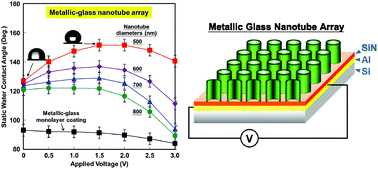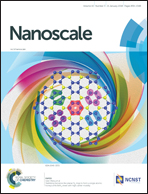Fabrication of an artificial nanosucker device with a large area nanotube array of metallic glass†
Abstract
The concurrent attachment and detachment movements of geckos on virtually any type of surface via their foot pads have inspired us to develop a thermal device with numerous arrangements of a multi-layer thin film together with electrodes that can help modify the temperature of the surface via application of a voltage. A sequential fabrication process was employed on a large-scale integration to generate well-defined contact hole arrays of photoresist for use as templates on the electrode-based device. The photoresist templates were then subjected to sputter deposition of the metallic glass Zr55Cu30Al10Ni5. Consequently, a metallic glass nanotube (MGNT) array having a nominal wall thickness of 100 nm was obtained after removal of the photoresist template. When a water droplet was placed on the MGNT array, close nanochambers of metallic glass were formed. By applying voltage, the surface was heated to increase the pressure inside the nanochambers; this generated an expanding force that raised the droplet; thus, the static water contact angle (SWCA) was increased. In contrast, a sucking force was generated during surface cooling, which decreased the SWCA. Our fabrication strategy exploits the MGNT array surface as nanosuckers, which can mimic the climbing aptitude of geckos as they attach to (>10 N m−2) and detach from (0.26 N m−2) surfaces at 0.5 and 3 V of applied voltage, respectively. Thus, the climbing aptitude of geckos can be mimicked by employing the processing strategy presented herein for the development of artificial foot pads.



 Please wait while we load your content...
Please wait while we load your content...